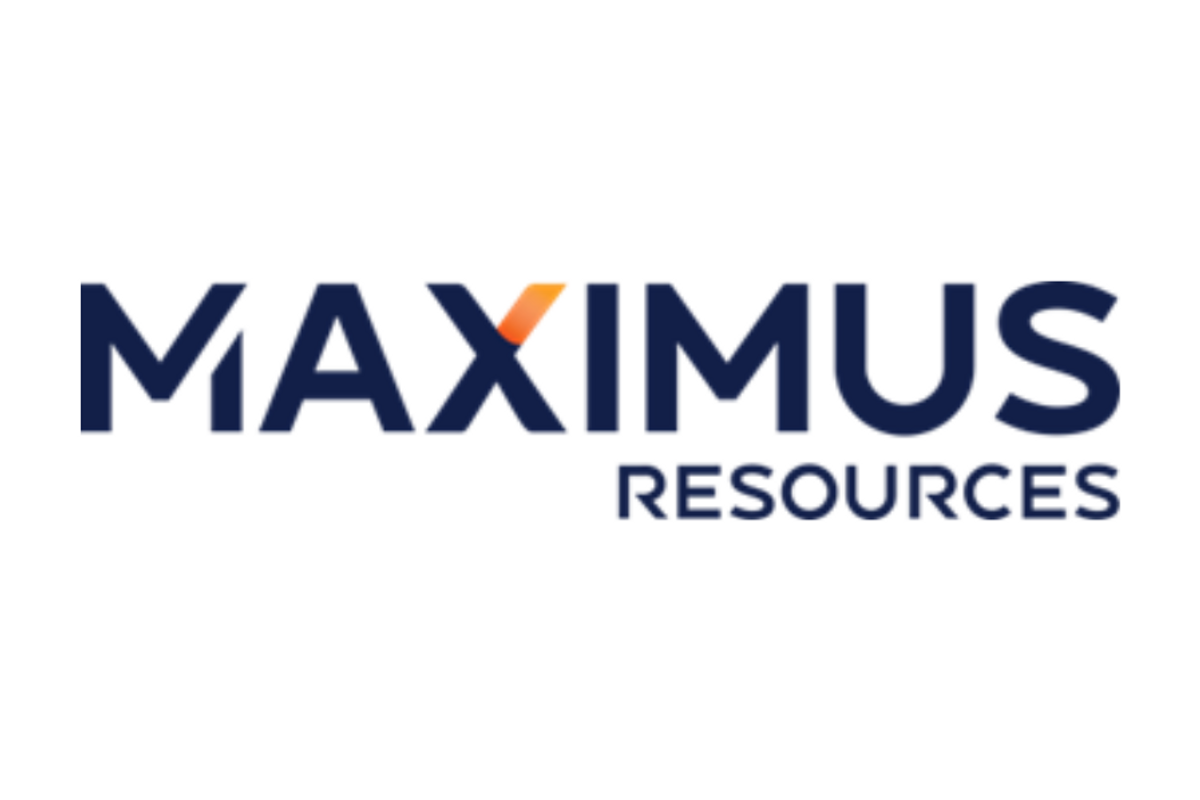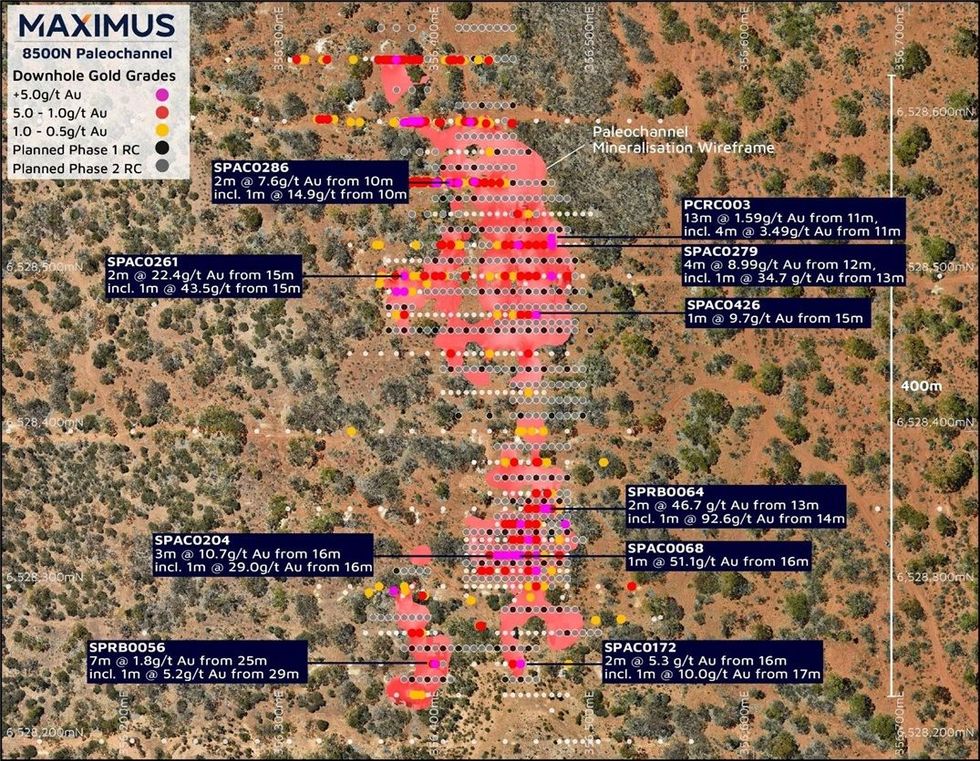
October 07, 2024
Maximus Resources Limited (‘Maximus’ or the ‘Company’, ASX:MXR) is pleased to advise shareholders of the commencement of a ~3,000m Reverse Circulation (RC) drill program at the Company’s 100Å owned 8500N Paleochannel (8500N) (Eighty-five Hundred North), located 25km from Kambalda, Western Australia.
- ~3,000m Reverse Circulation (RC) drill program at the 8500N Paleochannel (8500N) has commenced targeting shallow high-grade mineralisation where legacy and recent drill intersections include:
- 2m @ 46.7 g/t Au from 13m incl. 1m @ 92.6g/t Au from 14m (SPRB0064)
- 3m @ 10.7g/t Au from 16m incl. 1m @ 29.0g/t Au from 16m (SPAC0204)
- 2m @ 22.4g/t Au from 15m incl. 1m @ 43.5g/t from 15m (SPAC0261)
- 1m @ 51.1g/t Au from 16m (SPAC0068)
- 4m @ 8.99g/t Au from 12m incl. 1m @ 34.7 g/t Au from 13m (SPAC0279)
- 13m @ 1.59g/t Au from 11m incl. 4m @ 3.49g/t Au from 11m (PCRC003)
- Staged infill RC drill program designed to improve geological confidence of the 8500N Paleochannel while testing along strike and mineralisation extending into the underlying saprolite zones.
- 8500N is located on granted mining tenements, with significant mine infrastructure and completed environmental Flora and Fauna baseline studies, reducing the mine approval timeline.
- 8500N Paleochannel represents a low-cost, low-risk production opportunity due to its shallow high-grade gold mineralisation (average 15m below surface) and free-digging qualities of the mineralised paleo gravels and overburden material.
The first stage of the drill program consists of ~100 RC holes (~3,000m) designed to improve the geological confidence of the shallow paleochannel, while testing for potential extension of mineralisation in the saprolite zone beneath the paleochannel, as identified during the initial drill program (ASX announcement 18 September 2024). Several drill traverses will also be undertaken to test for extension along strike to the south (Figure 1). The complete drill program is designed to be completed in several stages to ensure optimal drilling effectiveness.
8500N Paleochannel
The 8500N Paleochannel is located within a granted mining tenement, between the Company’s Wattle Dam Gold Mine and the underlying 8500N gold deposit (Figure 2). Paleochannels are remnants of ancient rivers or stream channels that have been buried by younger sediments. Paleochannels can contain concentrations of high-grade alluvial gold that accumulate over millions of years and are generally shallow and flat-lying with free-digging qualities (not requiring drill and blasting) of the mineralised paleo gravels and overburden material, which can provide significant economic advantages.
Maximus’ 8500N is situated within the Lefroy Paleodrainage System, a significant ancient drainage network in the Eastern Goldfields region that contains several well-known paleochannel gold deposits such as Neptune, Africa, and Mandilla. The mined Neptune and Africa paleochannel deposits, part of Gold Fields Limited (JSE:GFI) St Ives Gold Camp, had a reported mineralised thickness of 1-3 metres recovering ~87,000 oz at 3.32 g/t Au. Similarly, Astral Resources’ NL (ASX:AAR) Mandilla paleochannel, which is situated ~2 km east of 8500N (Figure 2), was mined between 2006-2007, producing approximately 23,000 oz at 7.5 g/t Au from a ~600-metre long paleochannel with a mineralised thickness of 1-4 metres. The proximity of the 8500N Paleochannel to these established deposits, highlights the prospectivity of the region, as paleochannels within the Lefroy Paleodrainage System have consistently proven to be productive sources of gold.
The shallow 8500N mineralisation is located between 5 and 20m below the surface, gradually dipping to the south along two separate interpreted trends, with a strike length of approximately 450m. Legacy drilling across the flat- lying paleochannel has shown known mineralisation thickness ranges from 1 to 4m, with several key markers of the paleo gravels to assist in effective mining.
Currently, no JORC-compliant gold resources are defined for the 8500N paleochannel. However, recent drilling has revealed gold mineralisation extending beyond the limits of legacy drilling, indicating strong potential for significant expansion of the previously defined mineralised zone (ASX announcement 18 September 2024).

A third party has held the 8500N Paleochannel area under a Special Prospecting License (SPL) (Figure 2), which has restricted Maximus from assessing the potential of the 8500N gold resource and 8500N paleochannel. No exploration work, excluding a small scout drill program, has taken place in the 8500N area since 2014. On the surrender of the SPL (ASX announcement 5 September 2024), Maximus can now progress unencumbered to re- evaluate the mineral resources of both the Paleochannel and 8500N deposit.
Click here for the full ASX Release
This article includes content from Maximus Resources Limited, licensed for the purpose of publishing on Investing News Australia. This article does not constitute financial product advice. It is your responsibility to perform proper due diligence before acting upon any information provided here. Please refer to our full disclaimer here.
MXR:AU
The Conversation (0)
Latest News
Latest Press Releases
Related News
TOP STOCKS
American Battery4.030.24
Aion Therapeutic0.10-0.01
Cybin Corp2.140.00